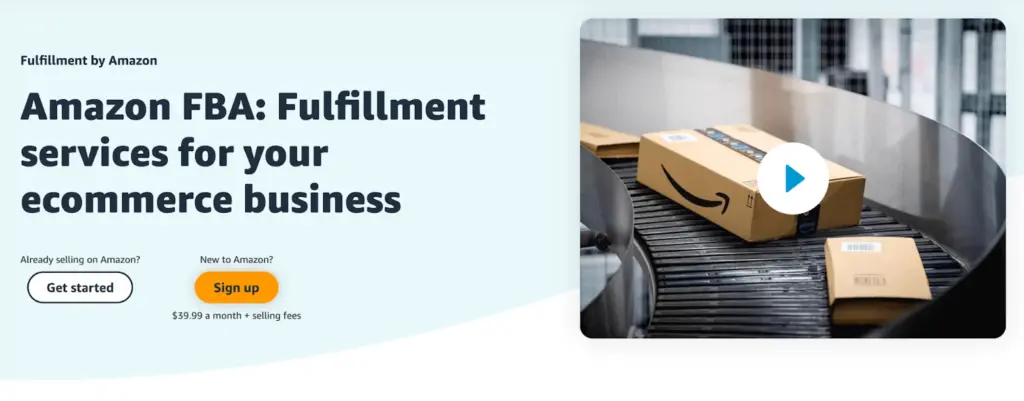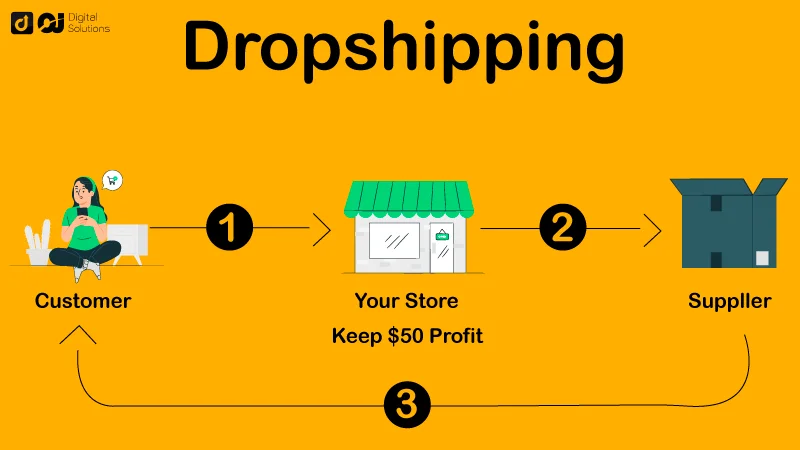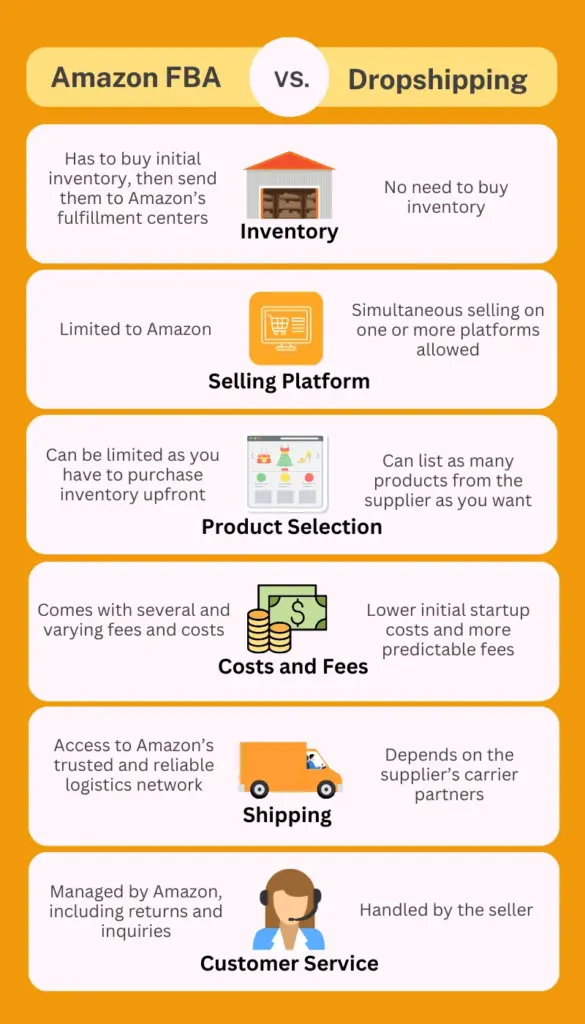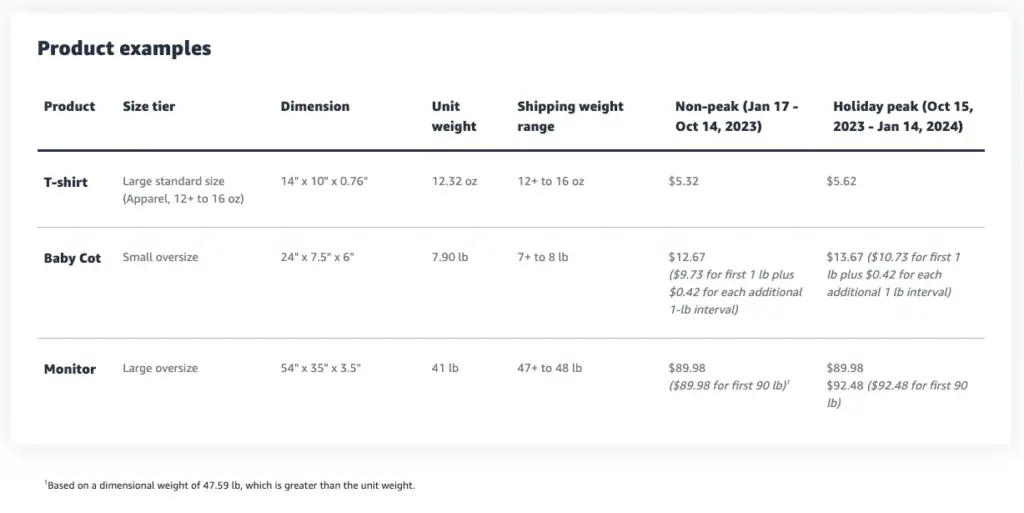Not sure which one between the Amazon FBA vs. dropshipping business models is right for you?
I’ve discussed these two similar yet widely different options with my clients and helped many others choose the best fit for them.
Now, I’ll help you pick the right path based on your business goals, desired level of control, and budget.
In this guide, I’ll discuss how dropshipping and Amazon FBA work and the differences in their processes. At the end, I’ll give you some tips on how to decide.
Let’s get started.
What Is Amazon FBA?

Amazon FBA (Fulfillment by Amazon) is the ideal ecommerce platform for entrepreneurs because of its high potential for scalability.
The ecommerce business program provides Amazon FBA sellers warehousing, packaging, and shipping services for their products. In other words, Amazon will prepare and ship customer orders for you.
On top of that, Amazon FBA handles customer services and returns as well.
Unlike a dropshipping store, you’re in charge of purchasing inventory and then shipping it to an Amazon Warehouse. Amazon will take it from there.
What Is Dropshipping?
Dropshipping is a type of ecommerce model that lets sellers list products without purchasing inventory upfront.
Instead, the seller serves as an intermediary between manufacturers, wholesalers, retailers, and customers.
To start a dropshipping business, you look for products to sell online, then list them to your online store. When a customer places an order, the dropship supplier packages and ships your merchandise.
Compared to other business models, this service allows you to set up your own business quickly with less capital.

With several marketplaces like Shopify, eBay, and Amazon competing for sellers, the dropshipping model has steadily increased in popularity over time.
However, if you choose Amazon as your dropshipping store, you must follow strict guidelines to avoid account suspension.
For instance, Amazon prohibits sellers from dropshipping orders from rival retailers like Walmart, Target, and Costco.
Comparing Amazon FBA vs. Dropshipping: Key Differences
Although both dropshipping and Amazon FBA let you outsource the fulfillment process, they differ significantly in terms of operation, control, and logistics.
Here are the key differences between them.

Inventory Management
With FBA, you first have to secure your initial inventory that you’ll then send to one of Amazon’s fulfillment centers.
Dropshipping lets you skip this step, allowing you to go straight to selling without buying inventory.
Selling Platforms
With a dropshipping business model, you can choose to sell on numerous platforms, including eBay and Shopify. You can easily manage inventory across several marketplaces using dropshipping tools.
FBA is a program under Amazon, so the inventory you hold in their warehouses is exclusive for the Amazon marketplace.
This isn’t necessarily a bad thing, as Amazon is a trusted brand with a huge customer base.
Product Selection
As you have to buy initial inventory, you may face limited choices when you go for the Amazon FBA business model.
However, this isn’t really an issue with dropshipping. You can list as many products from your dropshipping supplier as you want.
Costs and Fees
Dropshipping entails lower costs as you don’t have to purchase inventory upfront.
That aside, the costs associated with fulfillment can be higher and less predictable on Amazon. The fees vary depending on your product’s category, size tier, shipping weight, and season.
Amazon also have additional charges for:
- Aged inventory
- Removal orders
- Unplanned services
- Returns processing
Here’s a sample computation:

Shipping Process
Amazon takes care of shipping using their fast and reliable delivery network. This means you can take advantage of their special offers for Prime customers.
Just this 2023, Amazon reports that more than half of Prime member orders arrived the same or next day. In today’s online selling landscape, free and fast shipping is incredibly important.
With dropshipping, you have to be more careful in choosing your supplier. The fulfillment method depends on their own internal processes and network.
You must ensure they have reliable delivery partners to avoid issues with delays, missing packages, or damaged products.
Customer Service
This aspect is one of the key differentiators, as Amazon handles the customer concerns on your behalf.
On the other hand, dropshipping suppliers don’t have any point of contact with the customer. They only handle the fulfillment side of ecommerce.
As the dropshipper, you handle customer queries, concerns, returns, and more. This can become challenging if the issues are related to things you don’t have control over, like the packaging and delivery.
Which One Should You Choose? + Pros and Cons
Before you choose, let’s review their benefits and potential drawbacks. I’ve summarized them below:
| Amazon FBA | Dropshipping | |
|---|---|---|
| ✅Pros | – Access to Prime customers – Less hands-on as Amazon handles storage, packing, and shipping – Amazon brand’s credibility – No need to handle customer service – Prime shipping reliability | – Less upfront capital – No product inventory – More control over pricing, product selection, and own branding – Easier scalability without managing inventory – More control over a branded online experience |
| ❌Cons | – Higher initial investment when buying your own inventory – Higher fees (fulfillment and storage) – Limited control over customer interactions – Competition within Amazon’s platform | – Lower profit margins due to higher per-unit costs – Challenges with logistics, shipping, and product quality – Challenges with customer service |
That said, a large part of your decision will depend on your business goals.
For example, Amazon FBA is right for you if…
- You prefer less hands-on management and want access to Prime customers.
- You want to sell high-demand, well-established products where competition isn’t a significant concern.
- You’re willing to trade higher fees for convenience and the trust associated with the Amazon brand.
Meanwhile, dropshipping is best for you if…
- You want more control over product selection, pricing, and branding.
- You’re starting with limited capital and want to test various products without holding inventory.
- You’re willing to manage customer service to build a unique brand experience.
Here are some questions to help you with choosing the ideal online business model for you:
- How much is your capital (if any)?
- On which platforms are you planning to sell?
- What is your marketing budget for your e commerce business?
- How involved do you want to be in running the business?
- Are you great with customer service?
- What profit margins are you comfortable with?
Other Business Model Alternatives to Amazon FBA and Dropshipping
If you’re still on the fence and you want more options, you may also want to check out 3PL and Shopify Fulfillment Network. Let me give you a quick overview on both these services.
3PL (Third-Party Logistics) Companies
3PL providers are companies that offer outsourced logistics and fulfillment services. They manage various aspects of the supply chain, including warehousing, order fulfillment, shipping, and sometimes even customer service.
You can sell on Amazon FBM (Fulfilled by Merchant), but you’ll outsource inventory management to a third-party provider. You can also use this service on other platforms, like Shopify.
| ✅Pros | ❌Cons |
|---|---|
| Offers more customized solutions | Can have higher costs |
| Highly scalable | Requires more integration and coordination |
| May have additional services beyond just order fulfillment |
Shopify Fulfillment Network
SFN is similar to Amazon FBA but for Shopify merchants. It’s a solid alternative to those who want to set up their ecommerce store on the platform.
Like FBA, this service lets you send your inventory to one of Shopify’s fulfillment centers. Here, they’ll pack and deliver to your customer when you receive an order.
Shopify will also handle your returns and restocks for your returned inventory.
| ✅Pros | ❌Cons |
|---|---|
| Seamless integration for Shopify store owners | Relatively new service, which might present some scaling challenges |
| Uses machine learning to predict inventory needs | Less control and limited customization |
Frequently Asked Questions (FAQs)
Is Amazon Dropshipping More Profitable Than Shopify?
Amazon dropshipping is technically not allowed by Amazon.
Sellers who dropship using Amazon have to adhere to strict guidelines. They also have very limited control over their listings, making this option less appealing than dropshipping on Shopify.
Shopify dropshipping has a higher potential to be more profitable, given as you have more control over your listings and profit margins.
Can You Sell on Both Shopify and Amazon?
Yes, you can do multi-channel selling to maximize both business models.
Many Amazon sellers have listings on both Amazon and Shopify. Both platforms are compatible, and Shopify even allows you to connect to Amazon and other marketplaces.
Can I Use the Dropshipping Model on Amazon FBA?
No, you can’t use Amazon FBA to dropship when selling online.
You can dropship on Amazon as a regular seller using FBM (Fulfilled by Merchant), but that option becomes restricted once you’re on the FBA program.
Amazon’s FBA program requires you to send products to Amazon’s warehouse.
The Bottom Line
As confusing as the dropshipping vs. Amazon FBA debate is, coming up with a decision for your business is actually quite simple.
Don’t think about which one has a longer list of advantages or involves smaller risk. Start with what you want for your business.
When you take a closer look at it, it’s not about dropshipping vs. Amazon FBA. It’s about what you want to achieve vs. how much effort you’re willing to put in.
If you want a side hustle that’s uncomplicated to manage, dropshipping will make more sense.
Conversely, Amazon FBA will provide the perfect opportunity to be hands-on with a business and access to a big market if that’s what you’re looking for.






